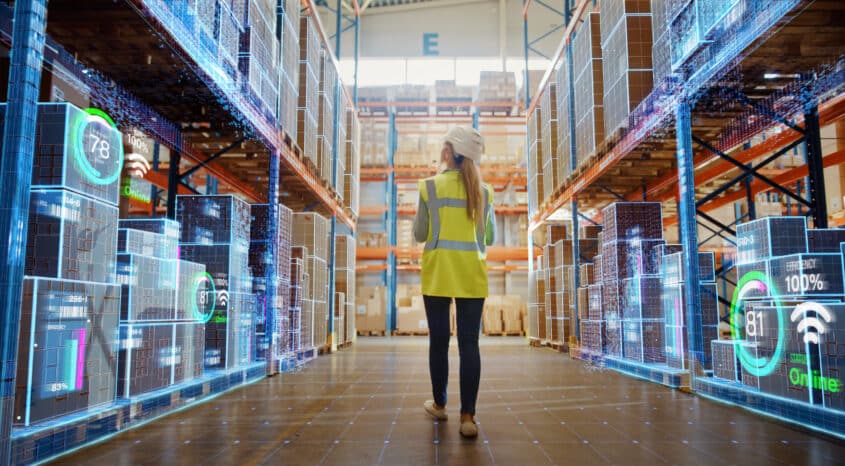The boom in online shopping during the coronavirus pandemic has seen many of us become increasingly happy to buy more of what we need and want online, with global e-commerce jumping to $26.7 trillion last year.
Now that we are finally transitioning out of the pandemic, we are entering a new era for retail – a Hyper-Scalable Era — defined by the ever-evolving demands of consumers and the agile, flexible systems that are required to meet them.
As part of this shift, leveraging the power of a multichannel approach will be essential for growth, and that means e-commerce merchants must rethink their sales and distribution channels.
Moving to multichannel is now essential for success in the post-pandemic world of e-commerce acceleration.
However, for brands, it presents a serious challenge.
Adopting new channels means adding layers of operational complexity. To handle it, and to make it a success, brands need speed, flexibility, optionality and an ecosystem of composable solutions that allow them to easily manage a changing roster of sales channels.
For many merchants — especially those that are locked into using a clunky traditional ERP or OMS — the increased admin and logistics of managing inventory across additional channels is a major roadblock.
That helps explain why lots of brands are hesitant to jump on the multichannel bandwagon.
In this blog, we’re going to look closer at the reasons why a multichannel approach is now so important, including the benefits (like more sales) and challenges (like increased complexity) it brings. We’ll explain why ‘traditional’ tech systems simply aren’t up to the job of supporting multiple channels in this new Hyper-Scalable Era, and how you can achieve the multichannel dream by choosing hyper-scalable solutions.
New era, new channels
In the Hyper-Scalable Era, there are more sales channels for brands to choose to sell on than ever before. There are marketplaces aplenty, including Amazon, eBay, OnBuy, Wayfair, Etsy, Walmart, Alibaba and Not on the High Street, on top of bricks-and-mortar and website sales.
There’s also a growing emergence of ‘alternative’ sales channels that all retailers should be aware of.
As shoppers radically change the way in which they discover and purchase items, non-traditional buying channels — such as livestream, WhatsApp, Pinterest, Instagram and even via video games such as Fortnite — have become more popular.
In our latest research, 49% of shoppers said they were increasingly using ‘alternative’ methods for their online shopping over the past year.
However, while multichannel selling can lead to more sales by increasing the variety of sales touchpoints, success for retailers in 2022 isn’t as simple as joining TikTok and considering the box ticked.
The channels that are popular with consumers, especially those in the 18-24 category, now are likely to have fallen out of favor in 12-24 months time, replaced with even newer and even more cutting-edge alternatives.
The big challenge for brands is to keep pace — and a considered strategy for doing so is essential.
A multichannel mindset
An overhaul of mindset, tactics and tech systems is needed. A top-to-toe shift to a multichannel, flexible, agile approach must be taken.
But before you start chasing the rainbow and adding new channels to your heart’s content, you need to make sure you’re prepared — and that means getting your operating system, the backbone of your business, right.
If you aren’t doing so already, you must switch to using technology that allows you to synchronize your inventory seamlessly across all your sales channels, and enables smart automation of key workflows to remove natural complexity and risk as you expand into new sales channels.
To make a success of your multichannel approach, you’ll also need the ability to quickly swap out channels as and when needed, with partners that support rapid connectivity and new channel integration.
Once the right tech system is in place, brands can look forward to enjoying the benefits of multichannel selling in the Hyper-Scalable Era, such as:
- Increased sales. Multiple channels typically means more sales. After all, increasing your sales channels makes your products accessible to potential customers across a bigger variety of sales touchpoints. This is reflected in a recent Brightpearl study, where merchants selling on multiple channels reported a higher level of growth — 33%, compared to only 8% growth when selling on a single channel.
- Boosted brand awareness. Increased brand recognition is a significant benefit of multichannel selling. Having a presence across several different platforms allows you to reach consumers who need your products but might not have thought to search for you – or are simply waiting for your brand to come to them.
- Improved customer experience. In the Hyper-Scalable Era, customer experience is everything – and a multichannel approach can help improve yours. These days, most people research and shop across an average of three touchpoints, online and offline, before buying. By being across multiple channels, you can be present at various parts of a buyer’s journey. This helps your customers enjoy a quicker, simpler path to purchase and a better shopping experience overall (which means they’re more likely to come back, too).
- Competitive advantage. Research shows that 75% of Gen Zs (18 to 24-year-olds) in the US, and 57% of Gen Zs in the UK, are likely to shop around so that they can buy on the cutting-edge channels they prefer. That means if you’re able to easily analyze channel performance and add or swap out channels rapidly in-line with customer trends, you can enjoy a significant advantage over your competitors.
Multichannel selling is undoubtedly beneficial for e-commerce businesses, but, as we’ve already touched on, it can introduce layers of complexity. Successful online retailers need to integrate their retail operations, from inventory and order management, through to CRM and accounting, with their e-commerce website.
It might sound daunting, but the process doesn’t need to be complicated, especially if you have a modernized retail operating system that puts sales data in one place and grants complete visibility for every online order.
The right technology should be able to connect you quickly and easily to all of the major e-commerce providers and marketplaces and allow you to manage your inventory, track your orders, and report on performance — all in one place.
Leading by example
Some successful retailers have already switched on to the need to be across multiple channels to succeed in the Hyper-Scalable Era.
For instance, Wayfair has become a popular additional marketplace channel for established brands such as Vitamix and Kitchenaid. Iconic denim brand Levi’s has successfully blended its online and offline shopping experiences by rolling out a ship-from-store feature.
And athletic wear company Under Armour has its own shopping app, in addition to acquiring the MyFitnessPal app as an extra channel to reach its audience. As another example, more and more retailers have already found the simplicity of mass texting as yet another effective channel to boost their sales.
However, although the benefits of multichannel selling are obvious and the need for it is clear, many retailers appear to be reluctant to get on board.
According to Brightpearl’s own research, just 14% of retailers in the UK, and a quarter of US firms, plan on adding new channels in 2022.
If adding channels is a surefire way to get in front of more potential customers, why are so many brands holding back?
This hesitancy is indicative of a wider problem: that lots of brands simply lack the necessary tech systems to easily add new channels.
For many, the operational logistics that a multichannel approach involves (managing inventory, orders and customers that come from various places inevitably adds complexity) is off-putting.
The tech roadblock
For any brand that’s still using a clunky traditional ERP or OMS, it’s more than off-putting; it’s a major roadblock.
That’s because these systems simply aren’t built for the Hyper-Scalable Era. They were built for a different, simpler time, specifically the Cloud Era of the 1990s. This was a time when all online shopping was rudimentary and exclusively done via desktop computers and when businesses only needed one simple system to deliver the same simple experience to every customer.
Lower-end OMSs (or Order Management Systems) are infamous for becoming slow and difficult to use when order volumes increase because their connections to e-commerce platforms and other systems can’t exchange data fast enough to process orders promptly. They’re also unreliable and typically come with inexpensive ‘all-in-one’ features that compromise quality — and ultimately lead to an unscalable system that prevents growth.
Meanwhile, the very architecture of ERPs makes it impossible for brands to quickly adjust to the ever-evolving demands of consumers in today’s market. ERPs take 420 days, on average, to go live for a customer — so they’re slow from the very start. They’re also extremely rigid — adding new sales channels or apps is either impossible or slow and very expensive.
When you also consider that 52% of brands in the US and 69% of UK-based retailers rely on an ‘all in one’ back-office enterprise resource planning (ERP) to run their businesses, the scale of the challenge to shift to a multichannel model becomes all too apparent.
Out with the old, in with the flexible
Trying to add multiple sales channels without the right technology infrastructure in place is simply a mistake.
Many brands rely on classic ERPs but the truth is that these aging systems can’t cope with the speed and agility required to quickly integrate new technologies and selling channels.
Back office systems that allow you to turn on and off new channels quickly and easily while maintaining full visibility is an essential requirement for expanding into more online markets while maintaining operational efficiency.
Brands must break free from the shackles of dated technology and insecure systems that don’t — and can’t — allow them to expand quickly and easily into new channels.
It’s important to note that when brands do try to add new channels without the right tech in place, it often goes horribly wrong.
This is an issue that appliance parts specialist Snap Supply is all too familiar with. The fast-growing brand attempted to add Amazon as a sales channel before having the right tech in place, but there were daily issues.
“We would oversell on Amazon and get suspended because we didn’t have enough in stock to ship what we sold that day,” said Snap Supply Co-founder Nick Ernst.
Luckily for Snap Supply, it has since implemented Brightpearl as its retail operating system —which meant adding and subsequently managing Amazon (and other sales channels) became easy.
“We were previously always afraid to take on new channels. That’s where Brightpearl comes into play. They can get you on those channels pretty quick and your inventory syncs automatically,” adds Nick.
The Snap Supply example illustrates that for brands that want to embrace multichannel selling, timing is critical.
Timing is everything
Multichannel selling adds complexity and pressure that traditional systems aren’t built to handle. It’s therefore essential that retailers get their operational ducks in a row and implement a hyper-scalable operating system before adding new channels.
The issue of timing is something multichannel fetish brand Honour is all too familiar with. The business originally built its technology stack around a clunky, legacy tech system but ran into endless costly and frustrating problems.
Director Joe Xeureb said: “We run a complex operation, so we were looking for a solution that would support multichannel selling across online e-commerce, marketplaces, wholesale and physical retail locations and could easily integrate to our other apps.”
Honour switched to using Brightpearl as a hyper-scalable retail operating system that makes it easy to sell across multiple channels, while streamlining and simplifying all back office operations.
Why are hyper-scalable systems better?
As we’ve already established, brands that want to succeed in this new post-pandemic landscape must be able to keep pace with consumer expectation and rapidly deploy cutting-edge features and services. Retailers need speed, flexibility, optionality and an ecosystem of composable solutions that allow them to easily manage a changing roster of sales channels.
A hyper-scalable system, built to scale as your business does, is the smartest choice.
In fact, more than a quarter of brands in both the UK and the US (29% and 28% respectively) specifically flag a need for hyper-scalability as a prime reason for planning to change their back office software.
Brightpearl is a Retail Operating System that’s purpose-built for the Hyper-Scalable Era. It’s packed with functionality that streamlines, simplifies and automates operations so modern brands can adopt a multichannel approach and reap the rewards.
Here are some of the reasons brands are choosing Brightpearl in the Hyper-Scalable Era:
- Easily add new channels. Unlike OMSs, Brightpearl offers a huge library of secure and stable Plug & Play integrations to e-commerce platforms (like Shopify and BigCommerce), channels (like eBay and Amazon) and tools (like ShipStation) so you can start selling quickly. No other system or solutions makes it as easy and safe to take a multichannel approach.
- Slick inventory management. Synchronize your inventory seamlessly across all your sales channels so that over-selling becomes a thing of the past and stock is always optimized.
- Built for composability. Brightpearl is built to scale as your business does. Curate a bespoke system of the apps and tools your business needs to thrive — and with a simple, transparent pricing system you only ever pay for what you need.
- Powerful automation. Smart, intuitive automation of key workflows removes natural complexity and reduces risk by 65% — especially important as you expand into new sales channels
- Real-time analysis. Make data-driven decisions on which sales channels to keep (and invest in) and which to scrap based on comprehensive analysis in real time.
The bottom line
The reality is that consumer-led trends will only become more frequent in the coming years, with brand new shopping channels emerging constantly alongside new ways to make shopping more convenient, immersive and fun.
To maintain the competitive edge, brands must be able to easily and quickly add new sales channels as part of an overarching multichannel approach. They also need the ability to manage the complexity that comes alongside multichannel selling, including keeping on top of inventory.
It is only by investing in processes and systems that support a multichannel approach that businesses can expand as they wish and keep their customers happy. Because brands that don’t get up to speed are certain to get left behind.
Want to discover more about the Hyper-Scalable Era and how it will impact your business? Download our latest report now.




